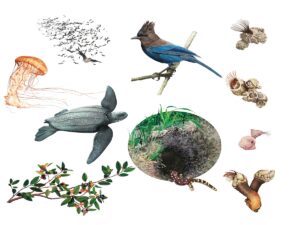With yellow stripes or spots running down its 8-inch, dark body, the California tiger salamander (Ambystoma californiense) seems like it would stand out in the field. But your chances of seeing one have always been slim, and may be getting slimmer.
The salamanders go to ponds to breed, and, on wet nights, you might catch sight of them swimming to attract a mate. When they swim, they push their legs up on their backs and shoot through the water “like little torpedoes,” according to Michael van Hattem, a wildlife biologist with Lawrence Livermore National Laboratory.
Van Hattem is one of few people to have seen this sight firsthand. California tiger salamanders spend most of their lives underground as extended houseguests in ground squirrel and pocket gopher burrows, emerging only once or twice in their lifetimes to mate in vernal pools or stock ponds. Their reclusiveness hasn’t been much protection: Scientists believe that salamander numbers are dwindling because of habitat destruction. Given that, activists and bureaucrats are now wrangling over the species’ status under the Endangered Species Act.
Because salamanders are such shy creatures, many of their habits remain a mystery. For instance, no one knows what they do underground. Do they lie dormant (called estivation)? Are they active? What do they eat? How do they get their food?
To answer these questions, van Hattem studied 52 salamanders in an artificial burrow rigged with cameras. Though the question of estivation is still unclear, the subjects of van Hattem’s study appeared active, even predatory, as they foraged for food, primarily insects. “One walked toward the camera with its head cocked,” he says. “It was unmistakable—it was stalking the camera.”
Despite their predatory behavior, the evolutionary odds are stacked against the California tiger salamander. Though they live 10 years in the wild (some have lived 20 years in captivity), they don’t reach sexual maturity until they are four to six years old. And since mating doesn’t occur during particularly dry winters, an individual salamander may mate only a few times in its life. Half may never breed at all.
When salamanders do breed, they can migrate over a mile to reach water, a dangerous trek for a small amphibian, and one reason why you might see them along roads during heavy rainstorms. Mating season can last several months, usually beginning around November, depending on precipitation. At the end of that time, they return to their burrows.
The female lays 400 to 1,300 eggs, which attach en masse to aquatic plants, but only a fraction of eggs make it to maturity. After they hatch, the larvae live in the water for three to six months, eating small crustaceans and mosquito larvae. Then, at the hottest time of the year, they make a run for the nearest burrow.
In the water, the salamanders are prey to bullfrogs, fish, wading birds such as herons, and raccoons and other mammals. Scientists don’t know what, if anything, preys on them in their burrows.
Historically, the California tiger salamander has filled a specialized niche in the California grassland. The hot, dry grassland summer is hostile to moisture-loving salamanders. But the California tiger salamander is linked to vernal pools—large seasonal bodies of still water that form in winter. Though the full extent of their role in this ecosystem is unclear, what is known is that generations of California tiger salamanders have migrated from burrow to vernal pool and from vernal pool to burrow for millennia.
But as agriculture and development have overtaken grasslands, the life cycle of the California tiger salamander has been interrupted. Where there used to be fields, now there are parking lots. Where there were mossy forests to cross, now there are busy streets. In Sonoma County, every known breeding pool is within 450 yards of a road.
The salamander historically ranged west of the Sierra from Sonoma to Santa Barbara. It once lived throughout the Central Valley, but was pushed into a bathtub ring around the foothills during the Gold Rush. In the Bay Area, the salamander is considered threatened in parts of Sonoma, Contra Costa, and Alameda Counties. It has disappeared from three counties across the state in recent memory.
However, spotting these creatures is not impossible. Some places to look include Los Vaqueros Watershed in Contra Costa County, Bethany Reservoir in Alameda County, and Lake Lagunita by Junipero Serra Boulevard and Campus Drive East in Stanford.
“The best way to see one is to wait for the nastiest weather you could imagine going out in,” says van Hattem. “Then go out and look for them.”

.jpg)



